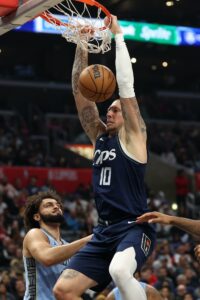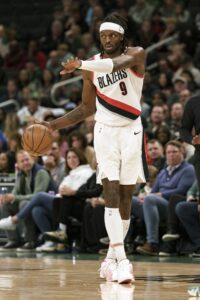Every player currently on an NBA roster whose 2023/24 salary is non-guaranteed will have his salary become guaranteed next Wednesday (January 10) if he’s still under contract at that point. However, this Sunday, January 7, is the real deadline to watch.
A player who is no longer on his team’s roster but who is still on waivers as of Jan. 10 will also have his salary guaranted. So if a team wants to avoid locking in a player’s full 2023/24 salary, he must be placed on waivers on or before this Sunday at 4:00 pm Central time — that would ensure that he clears waivers on or before Tuesday, Jan. 9.
As our tracker shows, there are 34 players on standard contracts who still don’t have fully guaranteed salaries for this season. Here are those players, who are on minimum-salary deals unless otherwise indicated:
- Dalano Banton (Celtics)
 Luke Kornet (Celtics)
Luke Kornet (Celtics)- Svi Mykhailiuk (Celtics)
- Lamar Stevens (Celtics)
- Harry Giles (Nets)
- Trendon Watford (Nets)
- Frank Ntilikina (Hornets)
- Ish Smith (Hornets)
- JT Thor (Hornets)
- Terry Taylor (Bulls)
- Sam Merrill (Cavaliers)
- Tristan Thompson (Cavaliers)
- Markieff Morris (Mavericks)
- Kevin Knox (Pistons)
- Gui Santos (Warriors)
- Aaron Holiday (Rockets)
- Boban Marjanovic (Rockets)
- James Johnson (Pacers)
- Bismack Biyombo (Grizzlies)
- Note: Biyombo’s salary is $5,000,000.
- Orlando Robinson (Heat)
- Dru Smith (Heat)
- Jose Alvarado (Pelicans)
- Ryan Arcidiacono (Knicks)
- Taj Gibson (Knicks)
- Isaiah Joe (Thunder)
- Aaron Wiggins (Thunder)
- Jonathan Isaac (Magic)
- Note: Isaac’s salary is $17,400,000.
- Jordan Goodwin (Suns)
- Moses Brown (Trail Blazers)
- Skylar Mays (Trail Blazers)
- Ish Wainright (Trail Blazers)
- Juan Toscano-Anderson (Kings)
- Luka Samanic (Jazz)
- Omer Yurtseven (Jazz)
- Note: Yurtseven’s salary is $2,800,000.
Keith Smith of Spotrac took a player-by-player look through this list earlier today, examining which guys are at the greatest risk of being waived before their salaries become guaranteed.
Some of these decisions – like the Pelicans with Alvarado, or the Thunder with Joe and Wiggins – involve regular rotation players who are earning the minimum, making them no-brainers — those players obviously won’t be released. In fact, it’s safe to assume that the majority of the 34 players in this group will hang onto their roster spots.
But we’ll likely see at least a small handful of these players cut within the next couple days as teams opt to create a little extra roster and financial flexibility. Those teams could take advantage of the newly opened 10-day contract window to bring in a new player or to immediately re-sign a player they just waived.
In addition to these 34 players on standard non-guaranteed contracts, there are 90 more who will be keeping a close eye on that January 7 waiver deadline.
For the first time this season, the salary guarantee date for players on two-way contracts lines up with the date for players on standard deals, so the two-way players who remain under contract through Sunday will be assured of their full-season salaries, regardless of whether they actually spend the rest of the season on a roster.
The full list of players on two-way contracts can be found right here.
Although we’ll likely see some two-way roster moves in the coming days, it’s worth noting that those salaries don’t count against the salary cap, and the financial commitment is pretty minor relative to standard contracts (a two-way player’s full-season salary is $559,782). So we should expect to see some clubs continuing to move two-way players on and off their rosters after the salary guarantee deadline comes and goes.

 January 10 is the date that all
January 10 is the date that all  A significant portion of the NBA’s offseason signees became eligible to be traded
A significant portion of the NBA’s offseason signees became eligible to be traded